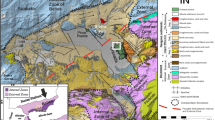Abstract
The delineation of shale oil sweet spots is a crucial step in the exploration of shale oil reservoirs. A single attribute such as total organic carbon (TOC) is conventionally used to evaluate the sweet spots of shale oil. This study proposes a probabilistic Fisher discriminant approach for estimating shale oil sweet spots, in which the probabilistic method and Gaussian mixture model are incorporated. Statistical features of shale oil facies are obtained based on the well log interpretation of the samples. Several key parameters of shale oil are projected to data sets with low dimensions in each shale oil facies. Furthermore, the posterior distribution of different shale oil facies is built based on the classification of each shale oil facies. Various key physical parameters of shale oil facies are inversed by the Bayesian method, and important elastic properties are extracted from the elastic impedance inversion (EVA-DSVD method). The method proposed in this paper has been successfully used to delineate the sweet spots of shale oil reservoirs with multiple attributes from the real pre-stack seismic data sets and is validated by the well log data.
Similar content being viewed by others
References
AbuZeina D, Al-Anzi F S (2018). Employing fisher discriminant analysis for Arabic text classification. Comput Electr Eng, 66: 474–486
Bao Y S, Zhang L Y, Zhang J G, Li J Y, Li Z (2016). Factors influencing mobility of Paleogene shale oil in Dongying Sag, Bohai Bay Basin. Oil & Gas Geo, 37(3): 408–414
Chen S, Zhao W Z, Zeng Q C, Yang Q, He P, Gai S H, Deng Y (2018). Quantitative prediction of total organic carbon content in shale-gas reservoirs using seismic data: a case study from the Lower Silurian Longmaxi Formation in the Chang Ning gas field of the Sichuan Basin, China. Interpretation (Tulsa), 6(4): SN153–SN168
Chen J Q, Pang X Q, Wang X L, Wang Y X (2020). A new method for assessing tight oil, with application to the Lucaogou Formation in the Jimusaer depression, Junggar Basin, China. AAPG Bull, 104(6): 1199–1229
Connolly P (1999). Elastic impedance. Leading Edge (Tulsa Okla), 18(4): 438–452
Espitalie J, Laporte J L, Madec M, Marquis F, Leplat P, Paulet J, Boutefeu A (1977a). Rapid method for source rock characterization and for determination of their petroleum potential and degree of evolution. Oil & Gas Sci Techn Revue, 32(1): 23–42
Fisher R A (1936). The use of multiple measurements in taxonomic problems. Annals of Eugenics, 7: 179–188
Foley D H, Sammon J W (1975). An optimal set of discriminant vectors. IEEE Trans Comput, C-24(3): 281–289
Gorynski K E, Tobey M, Enriquez D, Smagala T, Dreger J, Newhart R (2019). Quantification and characterization of hydrocarbon-filled porosity in oil-rich shales using integrated thermal extraction, pyrolysis, and solvent extraction. AAPG Bull, 103(3): 723–744
Grana D, Della Rossa E (2010). Probabilistic petrophysical-properties estimation integrating statistical rock physics with seismic inversion. Geophys, 75(3): O21–O37
Grana D, Fjeldstad T, Omre H (2017). Bayesian Gaussian mixture linear inversion for geophysical inverse problems. Math Geosci, 49(4): 493–515
Guo R Y, Bai Y Q, Li C N, Shao Y H, Ye Y F, Jiang C Z (2021). Reverse nearest neighbors Bhattacharyya bound linear discriminant analysis for multimodal classification. Eng Appl Artif Intell, 97: 104033
Hu R, Vernik L, Nayvelt L, Dicman A (2015). Seismic inversion for organic richness and fracture gradient in unconventional reservoirs: Eagle Ford Shale, Texas. Leading Edge (Tulsa Okla), 34(1): 80–84
Huang R Z (1984). A model for predicting formation fracture pressure. J China U Petrol (Natural Science), 8: 335–347
Jiang C R, Chen L H (2020). Filtering-based approaches for functional data classification. Wiley Interdiscip Rev Comput Stat, 12(4): 1–15
Jarvie D M (2012). Shale resource systems for oil and gas: part 2—shale-oil resource systems. AAPG Mem, 97: 89–119
Luo K, Zong Z Y (2020). Pyrolysis S1 discrimination of shale gas with Pre-stack seismic inversion. In: Annual Meeting of Chinese geoscience union 2020, Bei**g
Li K, Yin X Y, Zong Z Y (2020). Facies-constrained pre-stack seismic probabilistic inversion driven by rock physics. Scientia Sinica Terrae, 50(6): 832–850
Luo K, Zong Z Y (2019). Sweet spots discrimination of shale gas with Pre-stack seismic inversion. In: Annual Meeting of Chinese Geoscience Union 2019, Bei**g, 53: 29–31
Ma L, Lin Z L, Hu H F, Zhou D (2020). Seismic prediction method of fracture pressure in a shale formation. In: SEG International Exposition and 90th Annual Meeting, 1068–1072
Ouadfeul S, Aliouane L (2016). Total organic carbon estimation in shale-gas reservoirs using seismic genetic inversion with an example from the Barnett Shale. Leading Edge (Tulsa Okla), 35(9): 790–794
Ogiesoba O, Hammes U (2014). Seismic-attribute identification of brittle and TOC-rich zones within the Eagle Ford Shale, Dimmit County, South Texas. J Pet Explor Prod Technol, 4(2): 133–151
Raji M, Gröcke D R, Greenwell C, Cornford C (2015). Pyrolysis, porosity and productivity in unconventional mudstone reservoirs: free and adsorbed oil. In: Unconventional Resources Technology Conference, 11: 270–279
Rickman R, Mullen M J, Petre J E, Grieser W V, Kundert D (2008). A practical use of shale petrophysics for stimulation design optimization: all shale plays are not clones of the Barnett Shale. In: SPE Technical Conference and Exhibition
Rao C R (1948). The utilization of multiple measurements in problems of biological classification. J R Stat Soc B, 10(2): 159–193
Sena A, Castillo G, Chesser K, Voisey S, Estrada J, Carcuz J, Carmona E, Hodgkins P (2011). Seismic reservoir characterization in resource shale plays: “sweet spot” discrimination and optimization of horizontal well placement. In: 81st Annual International Meeting, SEG, Expanded Abstracts, 1744–1748.
Song G Z, Lin Y, Lu S F (2013). Resource evaluation method for shale oil and its application. Earth Sci Front, 20(4): 221–228
Verma S, Zhao T, Marfurt K J, Devegowda D (2016). Estimation of total organic carbon and brittleness volume. Interpretation (Tulsa), 4(3): T373–T385
Wang H J (2017). Prediction of geological dessert in shale gas with pre-stack seismic inversion. Dissertation for the Master’s Degree. Qingdao: China University of Petroleum (East China)
Wu L, Shen C H, Hengel A (2017). Deep linear discriminant analysis on fisher networks: a hybrid architecture for person re-identification. Pattern Recognit, 65: 238–250
Wang S, Feng Q, Javadpour F, **a T, Li Z (2015). Oil adsorption in shale nanopores and its effect on recoverable oil-in-place. Int J Coal Geol, 147–148: 9–24
Wang H, Yan S C, Xu D, Tang X O, Huang T (2007). Trace ratio vs. ratio trace for dimensionality reduction. In: Proceedings of the Conference on Computer Vision and Pattern Recognition. Minneapolis, USA: IEEE, 1–8
Wang Z, Ruan Q, An G (2016). Facial expression recognition using sparse local Fisher discriminant analysis. Neurocomputing, 174: 756–766
Yin X Y, Cui W, Zong Z Y, Liu X J (2014). Petrophysical property inversion of reservoirs based on elastic impedance. Chinese J Geophys, 57(12): 4132–4140
Yu J Q, Yu Z Q, Mao Z Q, Gao G, Luo K, Lei T, Zong Z Y (2020). Prediction of total organic carbon content in source rock of continental shale oil using pre-stack inversion. Geophys Prospect Petrol, 59(5): 823–830
Yin X Y, Zong Z Y, Wu G C (2015). Research on seismic fluid identification driven by rock physics. Sci China Earth Sci, 58(2): 159–171
Yin X Y, Yuan S H, Zhang F C (2004). Rock elastic parameters calculated from elastic impedance. CPS/SEG Technical Program Expanded Abstracts
Zong Z Y, Yin X Y, Wu G C (2013). Elastic impedance parameterization and inversion with Young’s modulus and Poisson’s ratio. Geophysics, 78(6): N35–N42
Zong Z Y, Yin X Y, Zhang F, Wu G C (2012a). Reflection coefficient and pre-stack seismic inversion with Young’s modulus and Poisson’s ratio. Chinese J Geophys, 55(11): 3786–3794
Zong Z Y, Yin X Y, Wu G C (2012b). Pre-stack inversion for rock brittleness indicator in gas shale. In: Annual meeting of Chinese Geoscience Union 2012. Bei**g, 17: 495
Acknowledgements
We would like to acknowledge the sponsorship of the National Natural Science Foundation of China (Grant Nos. 41974119 and 42030103) and Science Foundation from Innovation and Technology Support Program for Young Scientists in Colleges of Shandong Province and Ministry of Science and Technology of China.
Author information
Authors and Affiliations
Corresponding author
Rights and permissions
About this article
Cite this article
Luo, K., Zong, Z. Probabilistic Fisher discriminant analysis based on Gaussian mixture model for estimating shale oil sweet spots. Front. Earth Sci. 16, 557–567 (2022). https://doi.org/10.1007/s11707-021-0926-5
Received:
Accepted:
Published:
Issue Date:
DOI: https://doi.org/10.1007/s11707-021-0926-5




